Optical, Structural, and Synchrotron X-ray Absorption Studies for GaN Thin Films Grown on Si by Molecular Beam Epitaxy
Abstract
1. Introduction
2. Materials and Methods
3. Results
3.1. Surphase Morphology and Nomarski Microscopy
3.2. Structural Characterization by High-Resolution X-ray Diffraction
3.3. Spectroscopic Ellipsometry Measurements and Analysis of GaN Films on Si
3.4. Raman (532 nm) and Resonant Raman (325 nm) of Five GaN/Si
3.5. Raman Spectral Analyses by Spatial Correlation Model of Five GaN/Si
3.6. Near-Edge X-ray Absorption Fine Structure (NEXAFS) of GaN on Si
4. Conclusions
Author Contributions
Funding
Institutional Review Board Statement
Informed Consent Statement
Data Availability Statement
Acknowledgments
Conflicts of Interest
References
- Nakamura, S.; Nakamura, S.; Pearton, S.; Fasol, G. The Blue Laser Diode—The Complete Story; Springer: Berlin/Heidelberg, Germany, 2000. [Google Scholar]
- Feng, Z.C. (Ed.) Handbook of Solid-State Lighting and LEDs; CRC Press, Taylor & Francis Group: London, UK, 2017. [Google Scholar]
- Fay, P.; Jena, D.; Maki, P. (Eds.) High-Frequency GaN Electronic Devices; Springer: Berlin/Heidelberg, Germany, 2020. [Google Scholar]
- Di Paolo Emilio, M. GaN and SiC Power Devices From Fundamentals to Applied Design and Market Analysis; Springer: Berlin/Heidelberg, Germany, 2024. [Google Scholar]
- Gibiino, G.P.; Angelotti, A.M.; Santarelli, A.; Florian, C. Microwave Characterization of Trapping Effects in 100-nm GaN-on-Si HEMT Technology. IEEE Microw. Wirel. Compon. Lett. 2019, 29, 604–606. [Google Scholar] [CrossRef]
- Tong, W.; Harris, M.; Wagner, B.K.; Yu, J.W.; Lin, H.C.; Feng, Z.C. Pulse Source Injection Molecular Beam Epitaxy and Characterization of Nano-scale Thin GaN Layers on Si substrates. Surf. Coat. Technol. 2002, 200, 3230. [Google Scholar] [CrossRef]
- Wang, Z.T.; Yamada-Takamura, Y.; Fujikawa, Y.; Sakurai, T.; Xue, Q.K. Atomistic study of GaN surface grown on Si(111). Appl. Phys. Lett. 2005, 97, 032110. [Google Scholar] [CrossRef]
- Wu, Y.L.; Feng, Z.C.; Lee, J.F.; Tong, W.; Wagner, B.K.; Ferguson, I.; Lu, W. X-ray absorption and Raman study of GaN films grown on different substrates by different techniques. Thin Solid Film. 2010, 518, 7475. [Google Scholar] [CrossRef]
- Hestroffer, K.; Daudin, B. A RHEED investigation of self-assembled GaN nanowire nucleation dynamics on bare Si and on Si covered with a thin AlN buffer layer. Phys. Status Solidi RRL 2013, 7, 835–839. [Google Scholar] [CrossRef]
- Lin, P.-J.; Huang, S.-Y.; Wang, W.-K.; Chen, C.-L.; Chung, B.-C.; Wuu, D.-S. Controlling the stress of growing GaN on 150-mm Si (111) in an AlN/GaN strained layer superlattice. Appl. Surf. Sci. 2016, 362, 434. [Google Scholar] [CrossRef]
- Seredin, P.V.; Lenshin, A.S.; Mizerov, A.M.; Leiste, H.; Rinke, M. Structural, optical and morphological properties of hybrid heterostructures on the basis of GaN grown on compliant substrate por-Si (111). Appl. Surf. Sci. 2019, 476, 1049. [Google Scholar] [CrossRef]
- Li, Y.; Wang, W.; Li, X.; Huang, L.; Lin, Z.; Chen, X.; Li, G. Stress and dislocation control of GaN epitaxial films grown on Si substrates and their application in high-performance light-emitting diodes. J. Alloys Compd. 2019, 771, 1000. [Google Scholar] [CrossRef]
- Zhang, J.; Yang, X.; Feng, Y.; Li, Y.; Wang, M.; Shen, J.; Wei, L.; Liu, D.; Wu, S.; Cai, Z.; et al. Vacancy-engineering-induced dislocation inclination in III-nitrides on Si substrates. Phys. Rev. Mater. 2020, 4, 073402. [Google Scholar] [CrossRef]
- Seredin, P.V.; Goloshchapov, D.L.; Arsentyev, I.N.; Sharofidinov, S.; Kasatkin, I.A.; Prutskij, T. HVPE fabrication of GaN sub-micro pillars on preliminarily treated Si (001) substrate. Opt. Mater. 2021, 117, 111130. [Google Scholar] [CrossRef]
- Shen, J.; Yang, X.; Huang, H.; Liu, D.; Cai, Z.; Chen, Z.; Ma, C.; Sang, L.; Wang, X.; Ge, W.; et al. High-mobility n−-GaN drift layer grown on Si substrates. Appl. Phys. Lett. 2021, 118, 222106. [Google Scholar] [CrossRef]
- Zhong, Y.; Zhang, J.; Wu, S.; Jia, L.; Yang, X.; Liu, Y.; Zhang, Y.; Sun, Q. A review on the GaN-on-Si power electronic devices. Fundam. Res. 2022, 2, 462. [Google Scholar] [CrossRef]
- Zhu, S.; Shan, X.; Lin, R.; Qiu, P.; Wang, Z.; Lu, X.; Yan, L.; Cui, X.; Tian, P. Characteristics of GaN-on-Si Green Micro-LED for Wide Color Gamut Display and High-Speed Visible Light Communication. ACS Photonics 2023, 10, 92. [Google Scholar] [CrossRef]
- Chen, Z.; Yang, X.; Liu, X.; Shen, J.; Cai, Z.; Yang, H.; Fu, X.; Wang, M.; Tang, N.; Xu, F.; et al. Terrace Engineering of the Buffer Layer: Laying the Foundation of Thick GaN Drift Layer on Si Substrates. Adv. Electron. Mater. 2023, 9, 2300148. [Google Scholar] [CrossRef]
- Zhou, S.; Wan, S.; Zou, B.; Yang, Y.; Sun, H.; Zhou, Y.; Liang, J. Interlayer Investigations of GaN Heterostructures Integrated into Silicon Substrates by Surface Activated Bonding. Crystals 2023, 13, 217. [Google Scholar] [CrossRef]
- Qi, L.; Zhang, X.; Chong, W.C.; Lau, K.M. Monolithically integrated high-resolution full-color GaN-on-Si micro-LED microdisplay. Photonics Res. 2023, 11, 109. [Google Scholar] [CrossRef]
- Zhang, Y.; Wen, C.; Xing, Y.-K.; Cao, G.-B.; Zhang, R.-X.; Li, X.-J. Improving the rectification characteristics of GaN/Si heterojunction by constructing an interpenetrating two-phase interface layer. Appl. Surf. Sci. 2024, 649, 159016. [Google Scholar] [CrossRef]
- Zhang, Y.; Liu, S.; Ma, J.; Yao, Y.; Wang, B.; Xu, S.; Hou, B.; Liu, Z.; Zhang, J.; Hao, Y. More than 60% RF loss reduction and improved crystal quality of GaN-on-Si achieved by in-situ doping tert-butylphosphorus. J. Cryst. Growth 2024, 625, 127443. [Google Scholar] [CrossRef]
- Malin, T.; Maidebura, Y.; Mansurov, V.; Gavrilova, T.; Gutakovsky, A.; Vdovin, V.; Ponomarev, S.; Loshkarev, I.; Osinnykh, I.; Volodin, V.; et al. Influence of substrate nitridation conditions and buffer layer structures on the crack-free GaN layers on silicon substrate grown by ammonia-assisted molecular beam epitaxy. Thin Solid Film. 2024, 791, 140246. [Google Scholar] [CrossRef]
- Wang, J.; Houdré, R. Strain engineering and strain measurement by spring tethers on suspended epitaxial GaN-on-Si photonic crystal devices. Semicond. Sci. Technol. 2024, 39, 025010. [Google Scholar] [CrossRef]
- Zamir, S.; Meyler, B.; Salzman, J. Lateral confined epitaxy of GaN layers on Si substrates. J. Cryst. Growth 2001, 230, 341–345. [Google Scholar] [CrossRef]
- Yu, J.W.; Lin, H.C.; Feng, Z.C.; Wang, L.S.; Chua, S.J. Control and Improvement of Crystalline Cracking from GaN Thin films grown on Si by Metal-organic Chemical Vapor Deposition. Thin Solid Film. 2006, 498, 108–112. [Google Scholar] [CrossRef]
- Kim, M.-H.; Do, Y.-G.; Kang, H.C.; Noh, D.Y.; Park, S.-J. Effects of step-graded AlxGa1-xN interlayer on properties of GaN grown on Si (111) using ultrahigh vacuum chemical vapor deposition. Appl. Phys. Lett. 2001, 79, 2713. [Google Scholar] [CrossRef]
- Liu, J.; Huang, Y.; Sun, X.; Zhan, X.; Sun, Q.; Gao, H.; Feng, M.; Zhou, Y.; Ikeda, M.; Yang, H. Wafer-scale crack-free 10 μm-thick GaN with a dislocation density of 5.8 ×107 cm−2 grown on Si. J. Phys. D Appl. Phys. 2019, 52, 425102. [Google Scholar] [CrossRef]
- Lu, H.; Wang, L.; Liu, Y.; Zhang, S.; Yang, Y.; Saravade, V.; Feng, Z.C.; Klein, B.; Ferguson, I.T.; Wan, L.; et al. A comparative investigation for optical properties of GaN thin films grown on c- and m-face sapphire by metalorganic chemical vapor deposition. Semicond. Sci. Technol. 2022, 37, 065021. [Google Scholar] [CrossRef]
- Wei, W.; Wang, J.; Liu, Y.; Peng, Y.; Maraj, M.; Peng, B.; Wang, Y.; Sun, W. Effects of Thermal Annealing on Optical Properties of Be-Implanted GaN Thin Films by Spectroscopic Ellipsometry. Crystals 2020, 10, 439. [Google Scholar] [CrossRef]
- Yang, Y.; Liu, Y.; Wang, L.; Zhang, S.; Lu, H.; Peng, Y.; Wei, W.; Yang, J.; Feng, Z.C.; Wan, L.; et al. Optical and structural properties of aluminum nitride epi-films at room and high temperature. Materials 2023, 16, 7442. [Google Scholar] [CrossRef]
- Liu, Y.; Yang, Z.; Long, X.; Zhang, X.; Wei, J.; Huang, D.; Ferguson, I.T.; Feng, Z.C. Effects of thickness and interlayer on optical properties of AlN films at room and high temperature. J. Vac. Sci. Technol. A 2021, 39, 043402. [Google Scholar] [CrossRef]
- Rambadey, O.V.; Kumar, A.; Sati, A.; Sagdeo, P.R. Exploring the Interrelation between Urbach Energy and Dielectric Constant in Hf-Substituted BaTiO3. ACS Omega 2021, 6, 32231–32238. [Google Scholar] [CrossRef]
- Lee, J.-H.; Im, K.-S. Growth of High Quality GaN on Si (111) Substrate by Using Two-Step Growth Method for Vertical Power Devices Application. Crystals 2021, 11, 234. [Google Scholar] [CrossRef]
- Zhou, Y.; Zhou, S.; Wan, S.; Zou, B.; Feng, Y.; Mei, R.; Wu, H.; Shigekawa, N.; Liang, J.; Tan, P.; et al. Tuning the interlayer microstructure and residual stress of buffer-free direct bonding GaN/Si heterostructures. Appl. Phys. Lett. 2023, 122, 082103. [Google Scholar] [CrossRef]
- Feng, Z.C.; Wang, W.; Chua, S.J.; Zhang, P.; Williams, K.P.J.; Pitt, G.D. Raman scattering properties of GaN materials and structures under visible and ultraviolet excitations. J. Raman Spectrosc. 2001, 32, 840–846. [Google Scholar] [CrossRef]
- Saron, K.M.A.; Ibrahim, M.; Taha, T.A.; Aljameel, A.I.; Alharbi, A.G.; Alenad, A.M.; Alshammari, B.A.; Almutairi, G.N.; Allam, N.K. Growth of high-quality GaN nanowires on p-Si (111) and their performance in solid state heterojunction solar cells. Sol. Energy 2021, 227, 525–531. [Google Scholar] [CrossRef]
- Feng, S.; Zheng, Z.; Cheng, Y.; Ng, Y.H.; Song, W.; Chen, T.; Zhang, L.; Cheng, K.; Chen, K.J. Strain Release in GaN Epitaxy on 4° Off-Axis 4H-SiC. Adv. Mater. 2022, 34, 2201169. [Google Scholar] [CrossRef]
- Katsikini, M.; Pinakidou, F.; Arvanitidis, J.; Paloura, E.C.; Ves, S.; Komninou, P.; Bougrioua, Z.; Iliopoulos, E.; Moustakas, T.D. Comparison of Fe and Si doping of GaN: An EXAFS and Raman study. Mater. Sci. Eng. B 2011, 176, 723–726. [Google Scholar] [CrossRef]
- Li, L.; Zhu, S.; Cheng, L.; Qi, H.; Fan, Y.; Zheng, W. Probing carrier concentration of doped GaN single crystals from LO phonon-plasmon coupled modes. J. Lumin. 2022, 251, 119214. [Google Scholar] [CrossRef]
- d’Acapito, F.; Boscherini, F.; Mobilio, S.; Rizzi, A. Epitaxy and strain in the growth of GaN on AlN: A polarized X-ray absorption spectroscopy study. Phy. Rev. B 2002, 66, 205411. [Google Scholar] [CrossRef]
- Isomura, N.; Kikuta, D.; Takahashi, N.; Kosaka, S.; Kataoka, K. Local atomic structure analysis of GaN surfaces via X-ray absorption spectroscopy by detecting Auger electrons with low energies. J. Synchrotron Radiat. 2019, 26, 1951–1955. [Google Scholar] [CrossRef]
- Filintoglou, K.; Pinakidou, F.; Arvanitidis, J.; Christofilos, D.; Paloura, E.C.; Ves, S.; Kutza, P.; Lorenz, P.; Wendler, E.; Undisz, A.; et al. Size control of GaN nanocrystals formed by ion implantation in thermally grown silicon dioxide. J. Appl. Phys. 2020, 127, 034302. [Google Scholar] [CrossRef]
- Parida, S.; Sahoo, M.; Abharana, N.; Tromer, R.M.; Galvao, D.S.; Dhara, S. Effect of Oxygen and Aluminum Incorporation on the Local Structure of GaN Nanowires: Insight from Extended X-ray Absorption Fine Structure Analysis. J. Phys. Chem. C 2021, 125, 3225–3234. [Google Scholar] [CrossRef]
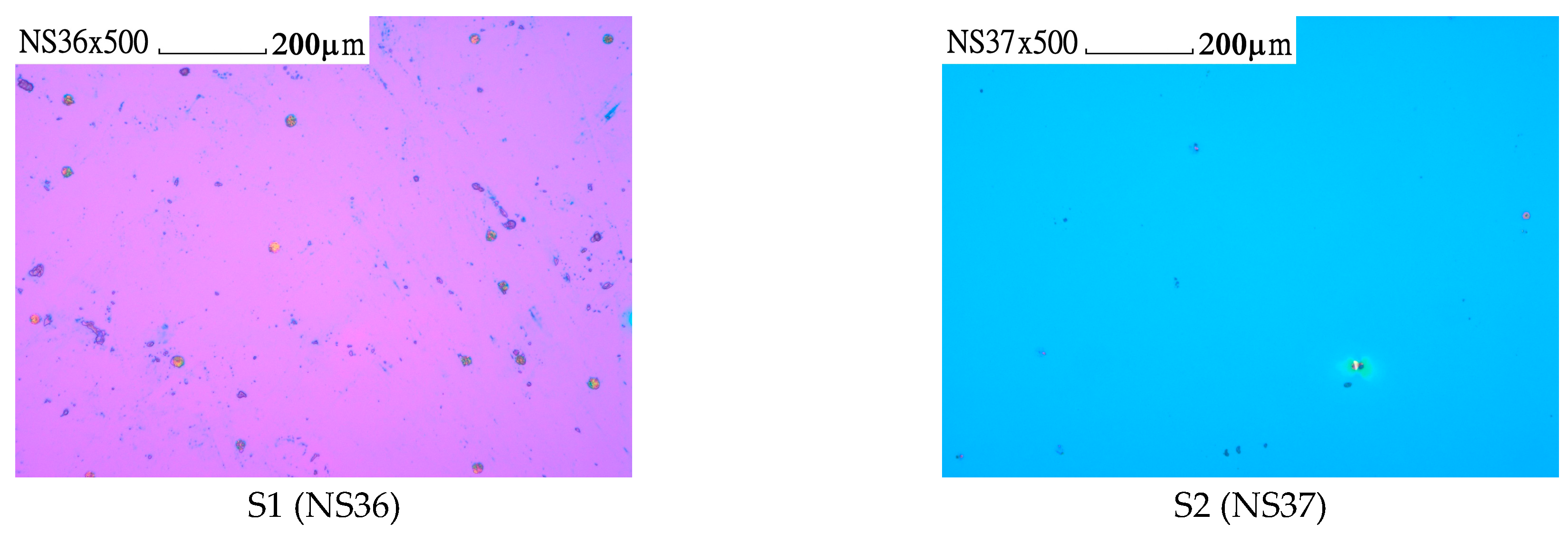


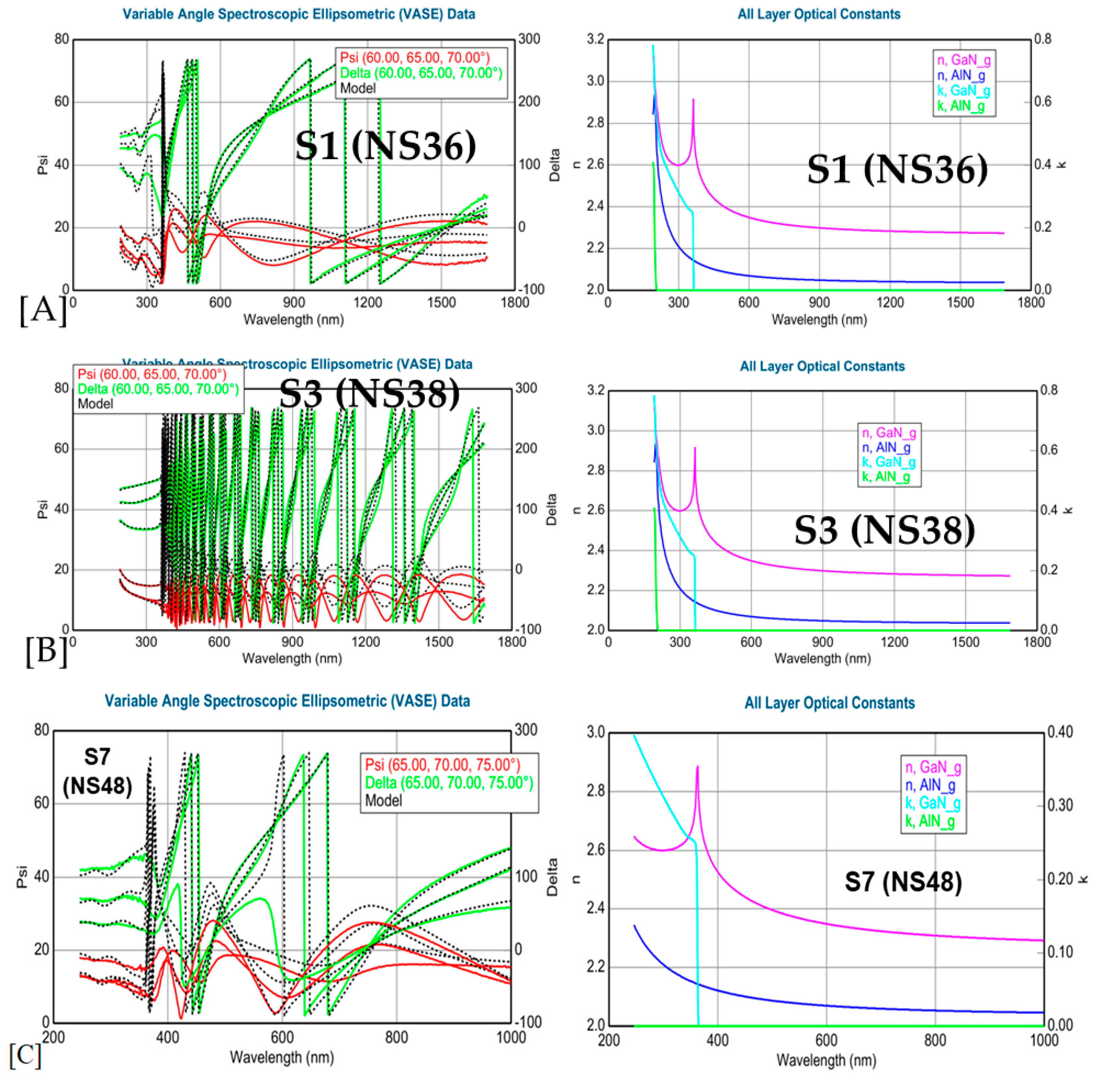
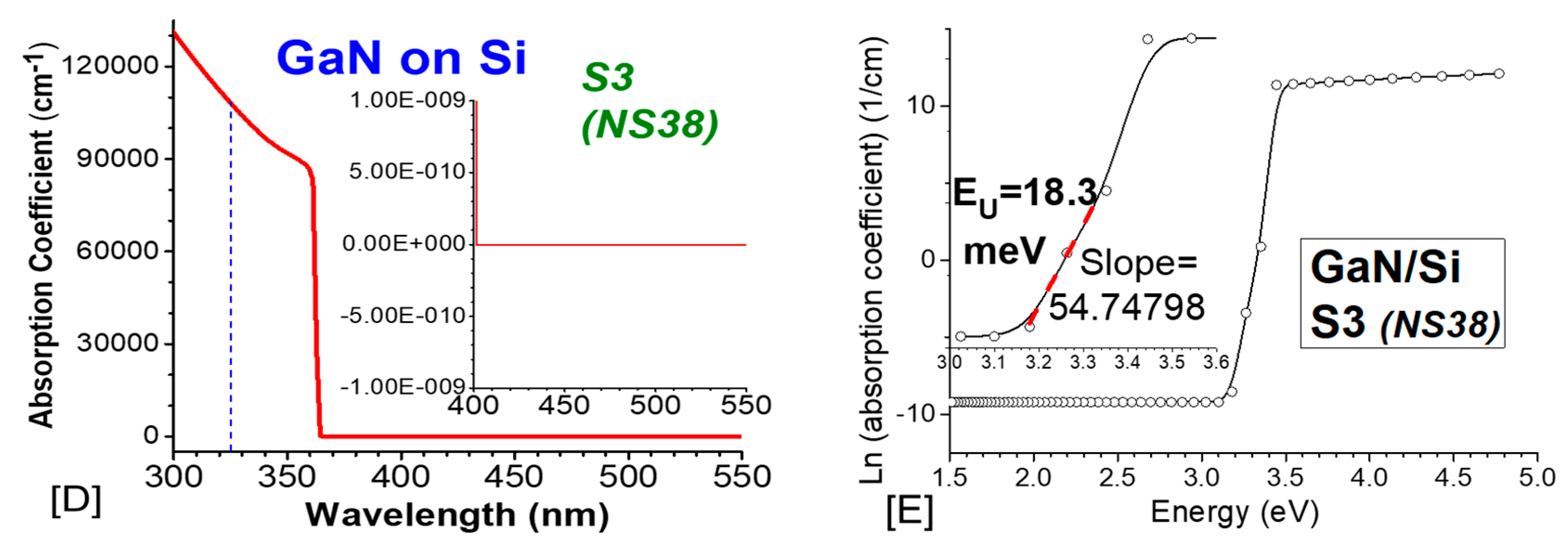
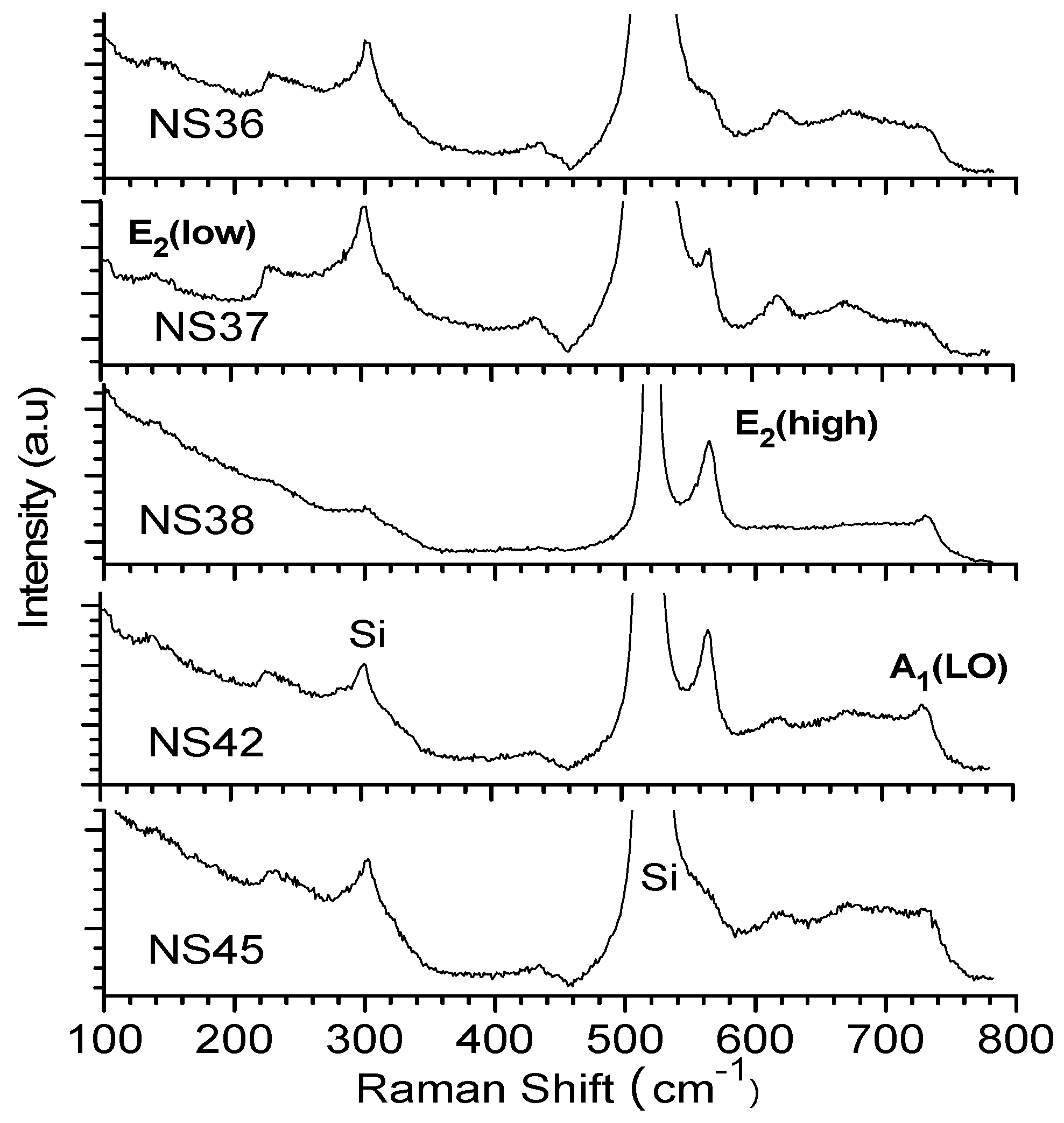



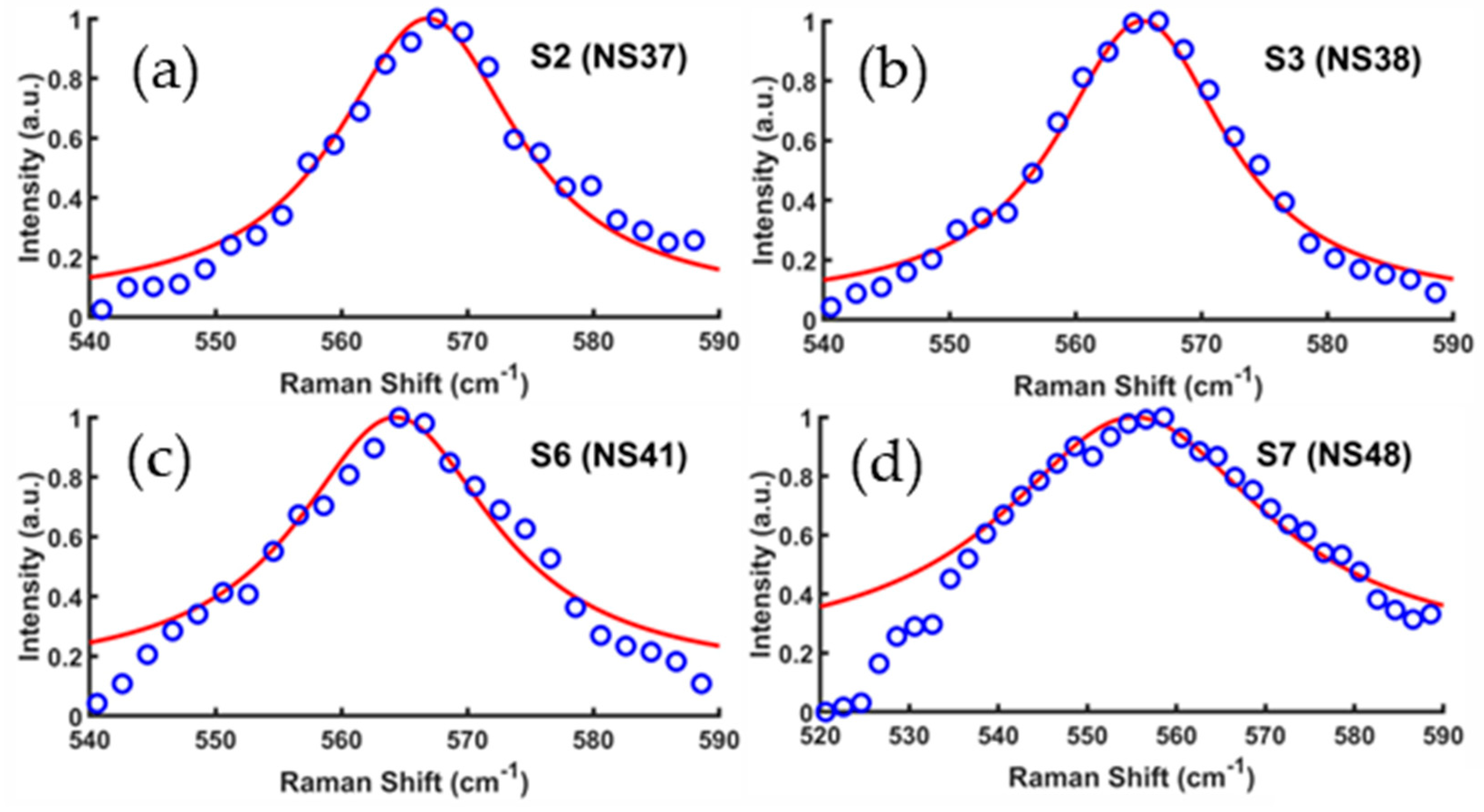


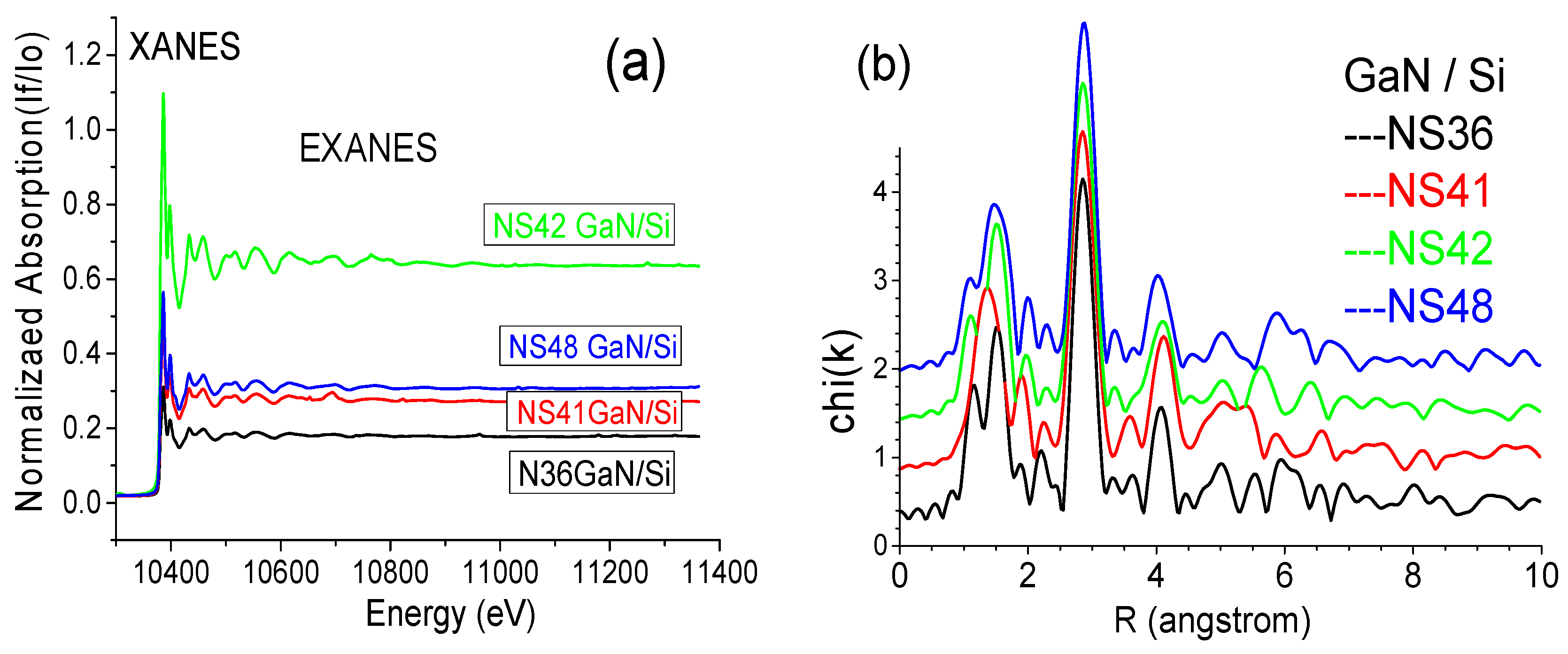

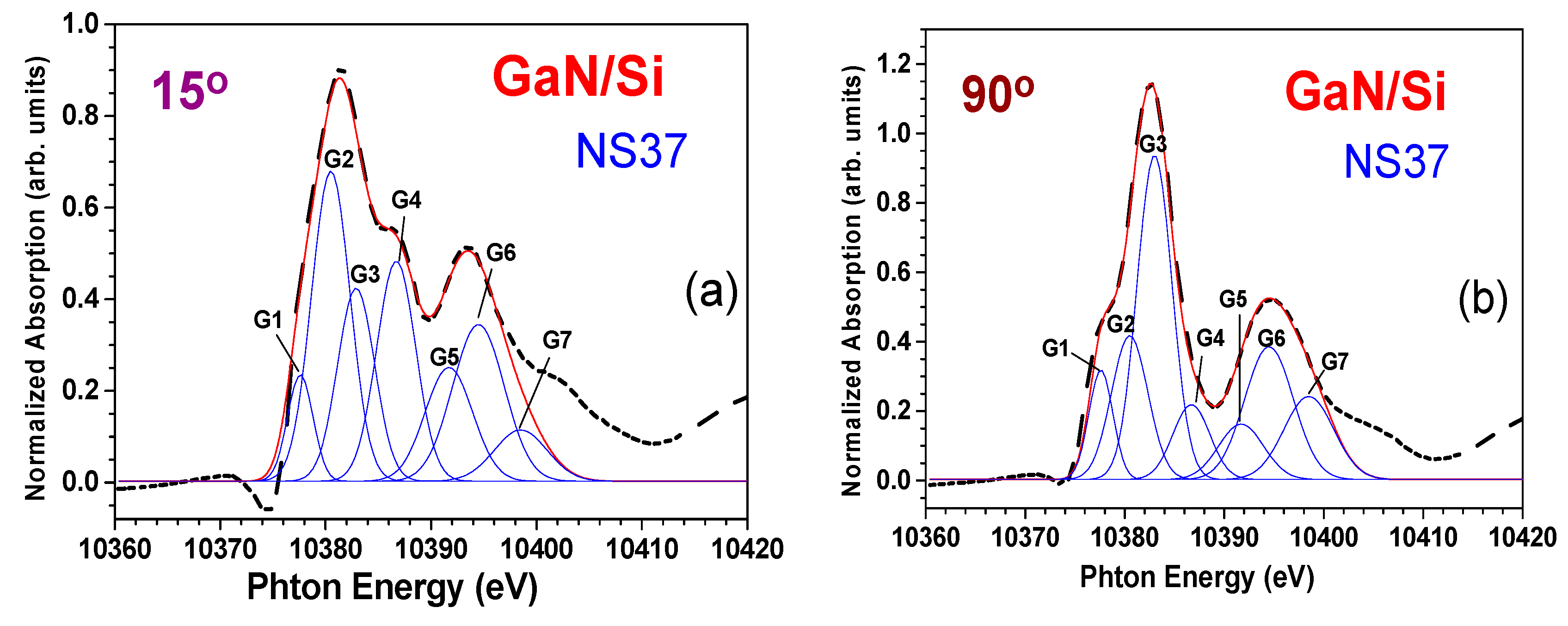
| Sample No. | S1 | S2 | S3 | S4 | S5 | S6 | S7 |
|---|---|---|---|---|---|---|---|
| Initial run no. | NS36 | NS37 | NS38 | NS42 | NS45 | NS41 | NS48 |
| Growth temp. (°C) | 650 | 700 | 700 | 700 | 650 | 650 | 750 |
| Growth time (min.) | 120 | 120 | 600 | 120 | 120 | 120 | 120 |
| Ga flux (×10−7 torr) | 2.1 | 2.0 | 2.1 | 1.9 | 2.5 | 2.5 | |
| Thickness (nm)–from SE | 162 | 175 | 1507 | 547 | 298 | 262 | 248 |
| Overview of NM | Fair | Best | Poor | Worst | Good | Worst | Good |
| PL GaN peak (RT) | Weakest | Strongest | Strong | Strong | Weak | ||
| Raman GaN E2 peak | Clearly | As a shoulder | Strong | Strong, narrowest | As a dim shoulder | ||
| Raman GaN A1(LO) peak | As a shoulder | As a shoulder | As a shoulder |
| Sample No. | S1 | S2 | S3 | S4 | S5 |
|---|---|---|---|---|---|
| Initial run no. | NS36 | NS37 | NS38 | NS42 | NS45 |
| Peak 2θ (0002) (°) | 34.52 | 34.49 | 34.50 | 34.51 | 34.48 |
| FWHM 2θ (0002) (°) | 0.254 | 0.216 | 0.205 | 0.219 | 0.356 |
| β: (π/180, Rad) | 0.004433 | 0.00377 | 0.003578 | 0.003822 | 0.006213 |
| β cosθ | 0.004234 | 0.00360 | 0.00342 | 0.00365 | 0.005934 |
| Crystallite size D (nm) | 32.76 | 38.53 | 40.56 | 38.0 | 23.37 |
| Lattice strain (×10−3) | 1.058 | 0.90 | 0.854 | 0.913 | 1.48 |
| Dislocation density (×1010) (cm−2) | 9.32 | 6.74 | 6.08 | 6.93 | 18.31 |
| Sample No. | S1 | S2 | S3 | S4 | S5 | S6 | S7 |
|---|---|---|---|---|---|---|---|
| Initial run no. | NS36 | NS37 | NS38 | NS42 | NS45 | NS41 | NS48 |
| Surface roughness (nm) | 3.3 | 2.7 | 8.3 | 4.9 | 7.1 | 3.3 | 10.5 |
| GaN thickness (nm) | 162 | 175 | 1507 | 547 | 298 | 262 | 248 |
| AlN buffer thickness (nm) | 20.0 | 20.0 | 20.0 | 20.0 | 20.0 | 20.0 | 20.0 |
| GaN band gap by SE (nm) | 362.95 | 362.80 | 362.64 | 362.64 | 362.79 | 362.80 | 363.13 |
| GaN band gap by SE (eV) | 3.416 | 3.418 | 3.419 | 3.419 | 3.418 | 3.418 | 3.415 |
| AlN buffer gap by SE (nm) | 197.64 | 197.32 | 197.48 | 197.63 | 197.48 | 197.32 | |
| AlN buffer gap by SE (eV) | 6.274 | 6.284 | 6.279 | 6.274 | 6.279 | 6.284 | |
| Eu by SE (meV) | 18.3 | 18.3 | 18.3 | 18.3 | 18.3 | 18.3 | 18.3 |
| Sample No. | S2 | S3 | S6 | S7 |
|---|---|---|---|---|
| Initial run no. | NS37 | NS38 | NS41 | NS48 |
| E2 (cm−1)-Lorentz fit | 567.9 | 565.9 | 568.5 | 559.2 |
| E2 FWHM (cm−1)-Lorentz fit | 22.5 | 40.0 | 58.3 | 66.9 |
| SCM fit A (cm−1) | 568.3 | 566.5 | 565 | 556.5 |
| SCM fit B (cm−1) | 109.5 | 100 | 101 | 100 |
| SCM fit L (Å) | 21 | 22 | 29 | 22 |
| SCM fit Γ0 (cm−1) | 17 | 16 | 19 | 36 |
| ωp (cm−1) from LO fit | 120 | 90 | 50 | 20 |
| Carrier concentration n (×1016 cm−3) | 16.3 | 9.2 | 2.8 | 0.45 |
| Angel | RGa-N (Å) | RGa-Ga in-plan (Å) | RGa-Ga out-plan (Å) |
|---|---|---|---|
| 15° | 1.936 | 3.193 | |
| 45° | 1.984 | 3.176 | 3.294 |
| 90° | 1.920 | 3.195 |
| Resonance | G1 | G2 | G3 | G4 | G5 | G6 | G7 | |||||||
|---|---|---|---|---|---|---|---|---|---|---|---|---|---|---|
| Incident angle | 15° | 90° | 15° | 90° | 15° | 90° | 15° | 90° | 15° | 90° | 15° | 90° | 15° | 90° |
| E (ev) | 10,377.6 | 10,380.5 | 10,383.5 | 10,386.7 | 10,391.7 | 10,394.5 | 10,398.5 | |||||||
| FWHM (ev) | 2.4 | 3.65 | 3.5 | 3.7 | 4.5 | 4.9 | 5 | |||||||
| Area (arb. Units) | 0.7 | 0.95 | 3.1 | 1.9 | 1.85 | 4.1 | 2.23 | 1 | 1.4 | 0.9 | 2.1 | 2.35 | 0.7 | 1.5 |
| Transition | 1s => pxy | 1s => pz | 1s => pxy | 1s => pz | 1s => pz | 1s => pxy | 1s => pxy | |||||||
Disclaimer/Publisher’s Note: The statements, opinions and data contained in all publications are solely those of the individual author(s) and contributor(s) and not of MDPI and/or the editor(s). MDPI and/or the editor(s) disclaim responsibility for any injury to people or property resulting from any ideas, methods, instructions or products referred to in the content. |
© 2024 by the authors. Licensee MDPI, Basel, Switzerland. This article is an open access article distributed under the terms and conditions of the Creative Commons Attribution (CC BY) license (https://creativecommons.org/licenses/by/4.0/).
Share and Cite
Feng, Z.C.; Liu, J.; Xie, D.; Nafisa, M.T.; Zhang, C.; Wan, L.; Jiang, B.; Lin, H.-H.; Qiu, Z.-R.; Lu, W.; et al. Optical, Structural, and Synchrotron X-ray Absorption Studies for GaN Thin Films Grown on Si by Molecular Beam Epitaxy. Materials 2024, 17, 2921. https://doi.org/10.3390/ma17122921
Feng ZC, Liu J, Xie D, Nafisa MT, Zhang C, Wan L, Jiang B, Lin H-H, Qiu Z-R, Lu W, et al. Optical, Structural, and Synchrotron X-ray Absorption Studies for GaN Thin Films Grown on Si by Molecular Beam Epitaxy. Materials. 2024; 17(12):2921. https://doi.org/10.3390/ma17122921
Chicago/Turabian StyleFeng, Zhe Chuan, Jiamin Liu, Deng Xie, Manika Tun Nafisa, Chuanwei Zhang, Lingyu Wan, Beibei Jiang, Hao-Hsiung Lin, Zhi-Ren Qiu, Weijie Lu, and et al. 2024. "Optical, Structural, and Synchrotron X-ray Absorption Studies for GaN Thin Films Grown on Si by Molecular Beam Epitaxy" Materials 17, no. 12: 2921. https://doi.org/10.3390/ma17122921
APA StyleFeng, Z. C., Liu, J., Xie, D., Nafisa, M. T., Zhang, C., Wan, L., Jiang, B., Lin, H.-H., Qiu, Z.-R., Lu, W., Klein, B., Ferguson, I. T., & Liu, S. (2024). Optical, Structural, and Synchrotron X-ray Absorption Studies for GaN Thin Films Grown on Si by Molecular Beam Epitaxy. Materials, 17(12), 2921. https://doi.org/10.3390/ma17122921







